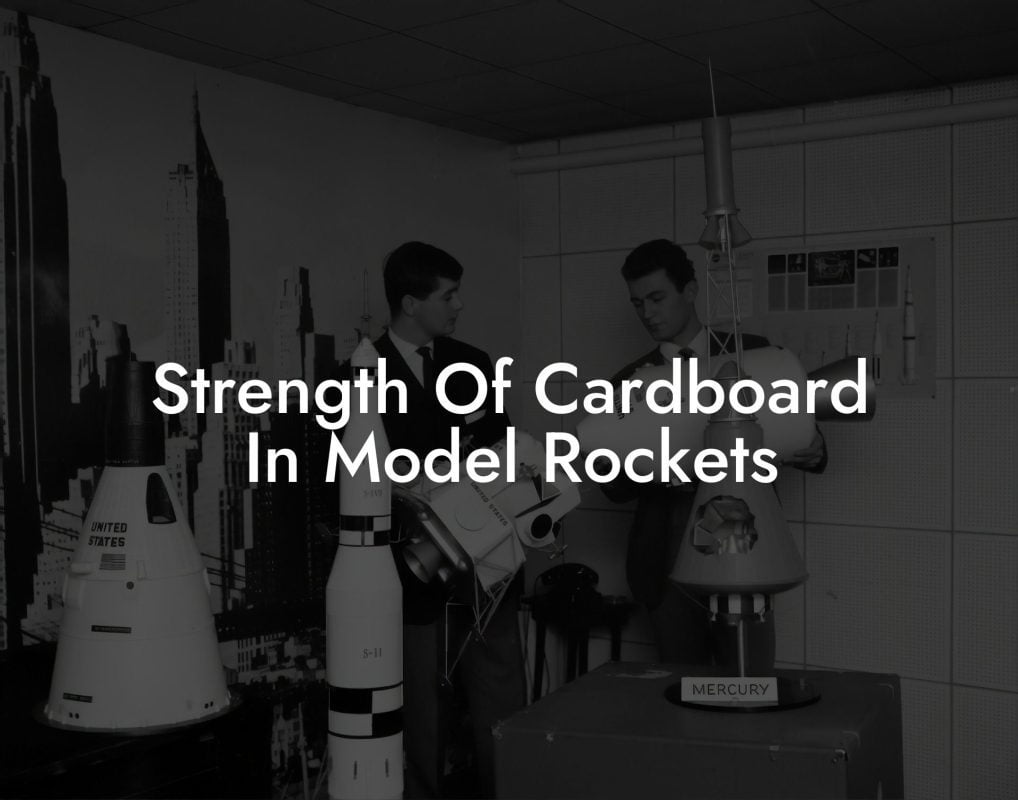Imagine the thrill of launching your model rocket into the sky, watching it soar to incredible heights, and then gently returning to Earth with a soft, controlled landing – all thanks to a trusty parachute. Welcome to the world of model rocketry, where the art of parachute design and deployment is a crucial aspect of the hobby. In this comprehensive guide, we'll delve into the fascinating realm of parachutes for model rockets, exploring the science behind them, different types, and expert tips for choosing and building the perfect parachute for your next launch.
Quick Links to Useful Sections
- The Science of Parachutes: How They Work
- Types of Parachutes for Model Rockets
- Materials and Construction: What to Consider
- Building Your Own Parachute: Tips and Techniques
- Parachute Deployment Systems: Options and Considerations
- FAQs: Parachutes for Model Rockets
- Resources and community Support: Your Next Steps
The Science of Parachutes: How They Work
A parachute is essentially a device that slows down an object's descent through the air, generating drag to counteract the force of gravity. In the context of model rockets, a parachute is deployed at the apogee (highest point) of the flight, allowing the rocket to descend slowly and land safely. The parachute's shape, size, and material all play a critical role in its performance.
The drag force created by a parachute is proportional to the square of its velocity, which means that as the rocket descends, the parachute's drag force increases, slowing it down further. This self-regulating effect ensures a stable and controlled descent.
Types of Parachutes for Model Rockets
When it comes to choosing a parachute for your model rocket, you'll encounter several types, each with its own strengths and weaknesses.
- Round Parachutes: The most common type, round parachutes are simple, inexpensive, and effective. They provide a stable descent and are suitable for most model rockets.
- Elliptical Parachutes: These parachutes offer a more efficient design, with a higher drag coefficient than round parachutes. They're ideal for larger or heavier model rockets.
- Square Parachutes: Also known as "ram-air" parachutes, these designs use a square or rectangular shape to maximize drag. They're often used in high-performance model rockets and require more complex deployment systems.
- Tandem Parachutes: This type features two parachutes in tandem, providing an added layer of redundancy and reliability. Tandem parachutes are commonly used in high-altitude or high-stakes model rocket launches.
Materials and Construction: What to Consider
The material and construction of your parachute can significantly impact its performance and durability.
Looking For The Best Model Rocket Kits? You'll Love These:
Fabric: Lightweight, yet strong and durable fabrics like nylon, polyester, or silk are ideal for model rocket parachutes. Look for materials with a high thread count and a smooth, even weave.
Shaping and Reinforcement: The parachute's shape and reinforcement are crucial for maintaining its structure and stability during deployment. Reinforcement materials like tape, glue, or stitching can help maintain the parachute's shape and prevent damage.
Suspension Lines and Attachments: The suspension lines and attachments connecting the parachute to the model rocket must be strong, reliable, and securely attached to prevent separation during deployment.
Building Your Own Parachute: Tips and Techniques
While commercial parachutes are available, many model rocket enthusiasts enjoy building their own custom parachutes. Here are some expert tips to get you started:
Choose the Right Fabric: Select a fabric that's suitable for model rocket parachutes, taking into account factors like weight, strength, and durability.
Design and Pattern: Create a design and pattern that suits your model rocket's size, shape, and weight. Consider factors like drag, stability, and deployment characteristics.
Shaping and Reinforcement: Use techniques like sewing, gluing, or taping to shape and reinforce your parachute. Ensure that the reinforcement is evenly distributed and doesn't compromise the parachute's overall structure.
Testing and Refining: Test your parachute in a controlled environment, making adjustments and refinements as needed to achieve optimal performance.
Parachute Deployment Systems: Options and Considerations
A reliable parachute deployment system is crucial for a successful model rocket launch.
Spring-Loaded Deployment: This system uses a spring to deploy the parachute, which can be triggered by a timer, altimeter, or other mechanism.
Pneumatic Deployment: This method uses compressed air or gas to deploy the parachute, often triggered by a timer or sensor.
Motor-Driven Deployment: This system uses a small motor to deploy the parachute, often in conjunction with a timer or sensor.
When choosing a deployment system, consider factors like reliability, complexity, and cost.
FAQs: Parachutes for Model Rockets
Here are some frequently asked questions about parachutes for model rockets:
1. What is the ideal parachute size for my model rocket?
The ideal parachute size depends on the model rocket's weight, size, and desired descent rate. A general rule of thumb is to use a parachute with a diameter of 1-2 inches per pound of rocket weight.
2. How do I determine the correct deployment altitude for my parachute?
The deployment altitude depends on the model rocket's apogee and the desired descent rate. A general guideline is to deploy the parachute at an altitude of 500-1000 feet above ground level.
3. Can I use a parachute from a commercial model rocket kit?
Yes, many commercial model rocket kits come with pre-made parachutes that can be used. However, these parachutes may not be optimized for your specific model rocket or flying conditions.
4. How do I ensure a stable and controlled descent with my parachute?
A stable and controlled descent can be achieved by selecting the right parachute size, shape, and material, as well as ensuring proper deployment and attachment to the model rocket.
Resources and community Support: Your Next Steps
Whether you're a seasoned model rocket enthusiast or just starting out, there are many resources available to help you improve your skills and knowledge.
Online Forums and Communities: Join online forums and communities dedicated to model rocketry, where you can connect with other enthusiasts, ask questions, and share knowledge.
Model Rocket Clubs and Organizations: Look for local model rocket clubs and organizations in your area, which often provide access to resources, expertise, and launch facilities.
Books and Guides: Explore books and guides on model rocketry, which can provide in-depth information on parachute design, deployment, and optimization.
Remember, the world of model rocketry is all about experimentation, innovation, and community. By sharing your knowledge and experiences, you can help others improve their skills and create a more vibrant and supportive community.
Looking For The Best Model Rocket Kits? You'll Love These:
Useful Interruption: Dive deeper into the world of Model Rockets with our most popular sections. If there is anything you think is missing or anything you would love for us to write about, just give us a shout.
- Getting Started & Basics With Model Rockets
- Model Rocket Design, Build & Customization
- Model Rocket Propulsion & Engine Technology
- Model Rocket Launch Techniques & Recovery
- Model Rocket Advanced Rocketry & Innovations
- Model Rocket DIY and Customization
- Model Rocket Equipment Reviews & Digital Tools
- Community, Competitions & Education
- Model Rocket Troubleshooting & FAQs
- Model Rocket Bonus/Seasonal & Niche Topics
A group of model rocket enthusiasts gathered at a field for their weekly launch event. Among them was Dave, a seasoned builder known for pushing the limits of hobby rocketry. This time, he had outdone himself.
“Ladies and gentlemen,” Dave announced, dramatically pulling a cloth off his latest creation, “I present to you: The Kraken!”
The crowd gasped. This wasn’t just a model rocket—it was a monster. The thing stood 8 feet tall, had six clustered engines, and was covered in enough duct tape to qualify as a classified aerospace project.
“Dave,” muttered Steve, the cautious safety officer, “Have you, uh… done the math on this?”
“Math?” Dave scoffed. “I built it in my garage at 3 a.m. with parts from eBay. This is an art piece, Steve.”
The countdown began.
5…
4…
3…
2…
1…
The engines ignited with a BOOM, and The Kraken shot up… kind of. It immediately did a violent barrel roll, narrowly missing the spectators before skyrocketing at an angle that could only be described as “legally questionable.”
The crowd collectively ducked as The Kraken flew straight over the adjacent cornfield, where Old Man Jenkins, the grumpiest farmer in town, was minding his business.
KABOOM!
The rocket disappeared behind the barn. A moment later, a flaming piece of Estes igniter wire landed at Steve’s feet. The silence was deafening.
And then—an unmistakable sound echoed across the field.
Jenkins’ shotgun being cocked.
“DAVE!!!” Steve shouted. “RUN.”
And that was the day Dave invented the first-ever biologically powered rocket booster: pure adrenaline.
To this day, nobody knows where The Kraken landed, but legend has it, it still haunts the skies, terrifying unsuspecting drones and low-flying birds.















